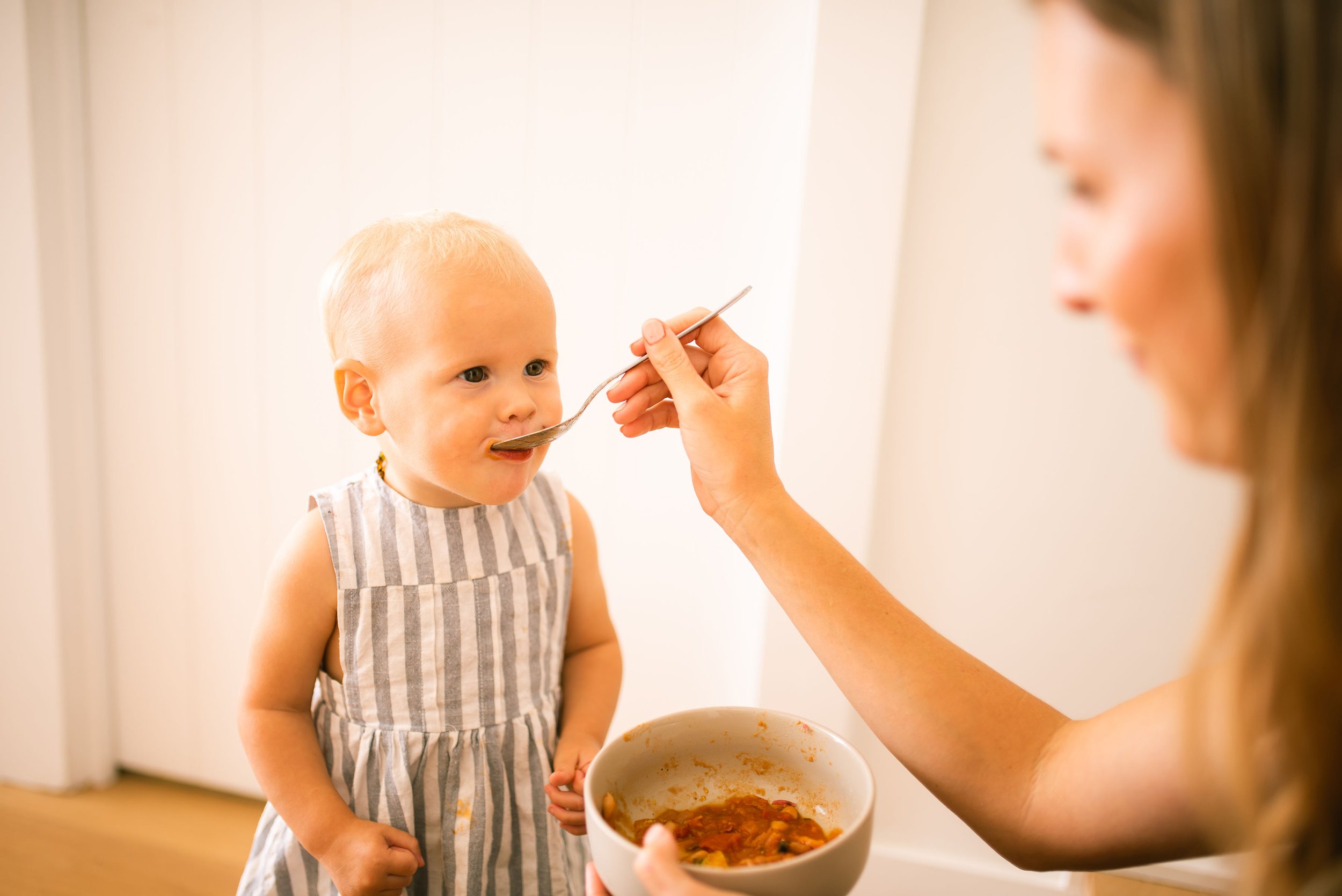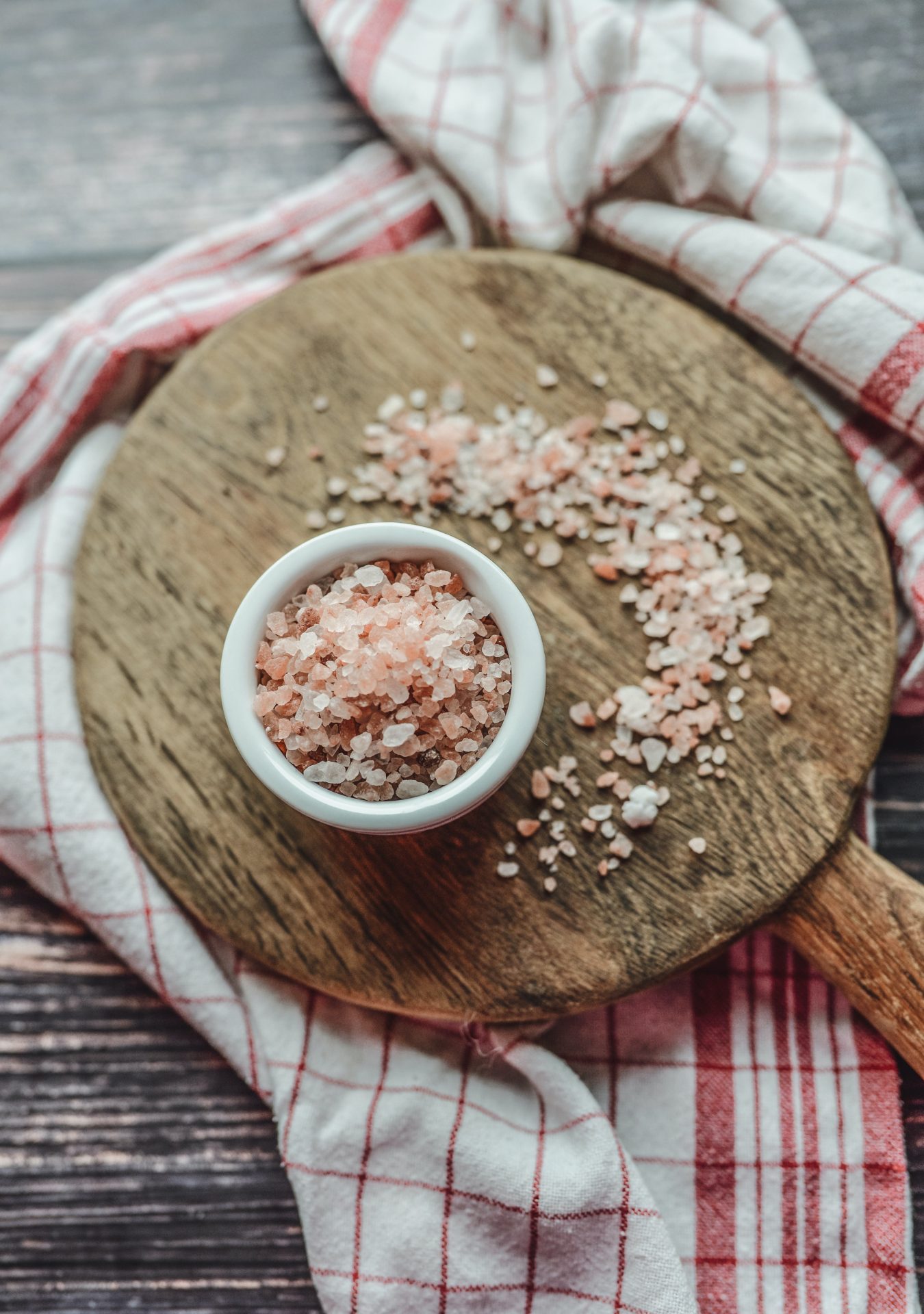Whilst we can often get caught up on the right ‘age’ to introduce solids, it is more important to observe for your babies developmental signs of readiness; as all babies develop at their own pace, in their own time! Just like some babies will walk at 9 months and others will walk at 18 months, there is no real ‘normal’.
Alarmingly, many paediatrician’s/GPs are still recommending starting solids from 4 months, but this is outdated advice. The current guidelines recommend solids begin at 6 months of age, but not before 4 months of age, with exclusive (meaning no other food or drink) breastmilk/formula given until then. This guideline has been set at 6 months because this is when MOST babies would meet the signs of readiness. However, some babies may reach them a bit earlier around 5.5 months, and some a bit later around 7 months.
My 4-5 month old is interested in solids
4-5 month old babies are sometimes very eager to participate in meal time, but it doesn’t necessarily mean they are ready for solids. This is just a normal developmental urge to do what everyone else is doing, to grab everything and put everything in their mouth!
This is a good time to let baby participate in family meal time utilising these ideas:
1. Let baby sit with the family at meal time (on laps, in high chair) – they learn SO much from just watching you!
2. Give baby a cup of expressed breastmilk or formula to play with and explore (remember to sterilise the cup).
3. Offer baby empty cups, bowls, spoons, plates (not ceramic of course!) to play with during meal time
4. Offer baby a momsicle – you can view recipe here
Signs of developmental readiness
The signs of readiness are important because they are indicators that your babies delicate and intricate digestive system is ready to handle solid foods. These signs are:
-
Your baby is able to sit up, unassisted.
Now this can get a bit confusing – what constitutes as sitting unassisted? The aim is that whilst they may still topple a little bit, that they can support themselves in a seated position for a period of time once in the highchair – without needing to ‘stuff’ the highchair, and without the aid of a bumbo.
This sign is the most vital, as our digestive systems are made up of muscles, which aid in moving the food from the mouth through the digestive system and back out through the bottom. When a baby has enough core strength to sit on their own, this is a good indication that their digestive system muscles are strong enough for food!
The other reason this is important, is that if they are slumping forwards or sideways in the highchair, then they are at an increased risk of choking or aspirating on foods. -
Good head and neck control.
Their head shouldn’t be ‘toppling’ around or slumping forward. This is very important from a safety point of view, because if their head is slumped then this can occlude the airway and increase the risk of choking.
Having strong head and neck control also helps them to turn their head towards or away from food to indicate if they have had enough food or want more food. -
Baby shows an interest in foods.
This is an important sign when in conjunction with the other signs above – as an interest in foods can happen early around 4 months. This often confuses parents that they are ready for solids, however, they would also eat a bit of dog poo if you put that in their hand, so its a good sign, but shouldn’t be the only sign 🙂
They should be able to reach for foods if you were to put some in front of them – such as reaching for foods you are eating!
Getting Started:
Once baby is showing all the signs of readiness, you can get started! The first few weeks can be a bit daunting, its ANOTHER thing we have to learn as parents! But once you get started hopefully it will be a fun and stress free experience for you all!
Method of feeding:
There seems to be a LOT of emphasis these days on which ‘method’ of feeding you will choose – which basically means, will you be offering your baby puree (spoon-feeding) or finger-food (baby led weaning) or a combination of both?! Please know, there is NO right option – ALL options have pro’s and con’s and to be honest, our babies often choose for us! Start with whatever method you feel the most comfortable with – because a relaxed parent means a relaxed mealtime! You can change your mind and method at any time, the only thing I would strongly encourage is that you at least introduce SOME finger foods by 8-9 months of age – to read more about different methods of feeding your baby check out this blog.
What should I feed my baby to start with?
I want to preface this by saying there is no ‘best’ first-food – but there are ‘best first-FOODS’. What this means is don’t focus on the single meal, but focus on what you’re consistently offering them! Most babies don’t eat much the first few weeks anyway, and food is so much more than just nutrients! Its a whole learning experience for them – new flavours/textures/smells and sensations!
I do have one golden rule for first foods though, and its to not start with a top allergen (read more about the top allergens here). We want to start with a food considered ‘low-allergenic’ just to make sure that they can tolerate any foods!
Contrary to what you might have been led to believe, babies don’t need to be offered bland and boring food like rice-cereal (read more about rice cereal here). In actual fact, its actually the best to introduce REALLY flavoursome foods from an early age – before any picky eating might arise! And you ABSOLUTELY can combine different foods right from the start – just don’t combine any top-allergens with another new food, so that you know what (if) your baby reacted to.
If there is a family history of any other allergen causing food, then I would also be mindful of this food when offering.
If your baby does have trouble digesting even foods considered low-allergenic, if they have eczema, asthma or a family history of food allergies then I would err on the side of caution and follow a slower more mindful approach to introducing new foods, as they could be at higher risk of developing allergies.
Your baby does have some nutrient requirements after 6 months of age that breastmilk or formula doesn’t quite meet the needs of anymore — predominately iron – for this reason I recommend trying to focus on nutrient-dense foods where you can. This means foods that provide a lot of nutrients in small amounts (and you can read more about their nutrient requirements on this blog post).
My favourite very ‘first foods’ that you might like to choose from are:
-
Bone broth (on its own or mixed in with some vegetables – read more about bone broth here)
-
Avocado (ripe slices or pureed with some bone broth or breastmilk/formula)
-
Root vegetables e.g. sweet potato, pumpkin, parsnip, swede, beetroot (peeled and steamed in slices, or puree’d with some bone broth)
-
Coconut cream – straight from the can or pureed with avocado or with steamed vegetables
-
Liver strips or pate or mixed through vegetable puree (read more about liver here)
-
Pasture-raised, organic meat – slow cooked in strips or pureed with vegetables and bone broth. Slow-cooked meats like chicken thigh, lamb shoulder and beef cheeks are great to start with!
-
Bone marrow – delicious mixed into puree or spread onto finger foods.
Once you have introduced some first foods, the idea is really that your baby starts eating what you eat (or a version there of) – there is SO much to say about the benefits of eating as a family, eating the same (or at least similar) meals, and modelling good eating habits to your baby. It will also reduce the cooking and preparation for you if you can all eat the same thing! This will generally also ensure your baby is eating a variety of foods and getting the nutrients they require (read more about essential nutrients here).
You can download my FREE first food guides here, to see what age group I would roughly recommend introduce certain foods at.
How much and how often?
When first starting out, your baby will likely not eat very much – if anything at all! As a general rule, I would start by offering them 1-2 tsp of food, or 1-2 pieces of finger food, once a day and gradually build from there. There is no ‘right time’ to offer solids, work in with your family and when suits you. Keep their milk feed (breastmilk or formula) as priority until 12 months of age, and offer solids some time after a milk feed, where they are happy and not overtired! For most 6ish month olds, this will be around mid-morning.
Read more about how much and how often to feed your baby here.
Equipment:
There is A LOT of equipment available to purchase these days which is so great but can be overwhelming. For this reason I have created a FREE starting solids equipment guide, which you can download here. This guide contain’s some discount codes for you to use.
MORE INFORMATION:
Starting solids can be overwhelming, and sometimes its nice to just have a resource to take all the guessing out of the picture! For this reason I created my book, Milk to Meals. A beautiful, hard cover book with almost 300 pages, packed with insights and tips on transitioning from milk, choosing a feeding method to suit your family, navigating the top allergenic foods, which nutrients to focus on to meet your baby’s nutritional needs and when to incorporate certain foods in their diet in the most mindful way (plus much more!). You can purchase the Milk to Meals book here.
References:
-
https://www.who.int/news-room/fact-sheets/detail/infant-and-young-child-feeding
-
https://www1.health.gov.au/internet/publications/publishing.nsf/Content/gug-director-toc~gug-solids
-
https://www.cdc.gov/nutrition/infantandtoddlernutrition/foods-and-drinks/when-to-introduce-solid-foods.html










+ show comments
- Hide Comments
add a comment